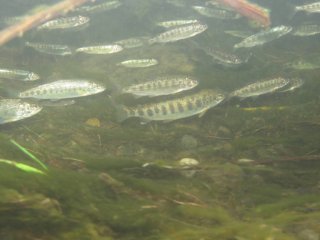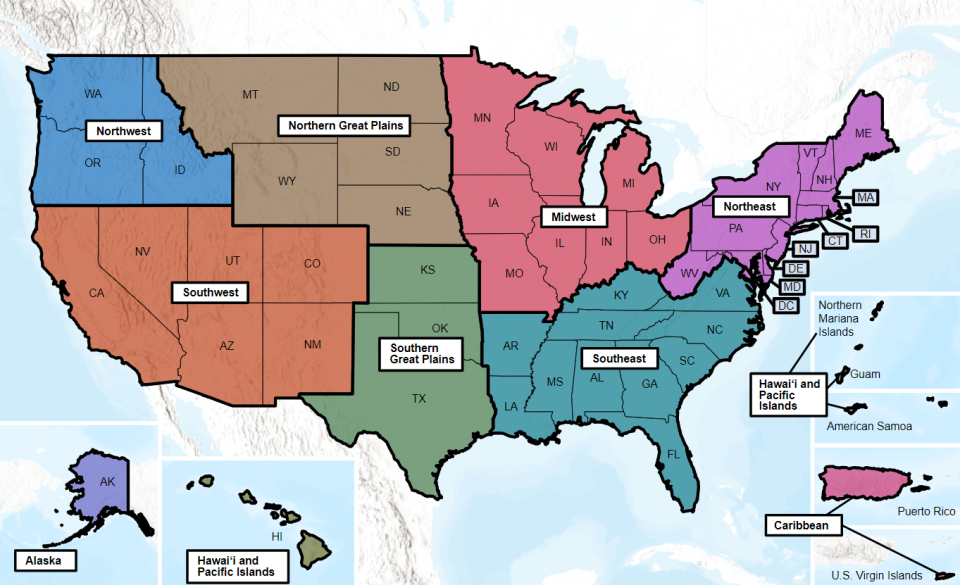Climate Change Connections: Oregon (Chinook Salmon)
Climate change is impacting all regions and sectors of the United States. The State and Regional Climate Change Connections resource highlights climate change connections to culturally, ecologically, or economically important features of each state and territory. The content on this page provides an illustrative example. As climate change will affect each state and territory in diverse ways, this resource only describes a small portion of these risks. For more comprehensive information about regional climate impacts, please visit the Fifth National Climate Assessment and Climate Change Impacts by Sector.
On this page:
Introduction: Chinook Salmon Play an Important Role in Pacific Northwest Ecosystems and Culture
Known sometimes as “King Salmon,” Chinook salmon have been living in Oregon waters for thousands of years. Chinook salmon are native to the Pacific Northwest, occupying coastal and fresh waters along and within western and northern Oregon.1 The Chinook are the largest salmon species in the Pacific Ocean, averaging around 30 pounds and recorded up to 129 pounds.2 After hatching in fresh water, Chinook migrate to the ocean to feed before eventually returning to the streams where they were born to spawn.3 Because the salmon life cycle involves both fresh water and salt water, they are vulnerable to changes in both ecosystems.

The Chinook is a culturally important species for many Tribes in the Pacific Northwest.4 The region is home to 43 federally recognized Tribes, and Indigenous Peoples have honored and harvested salmon for thousands of years.5,6 However, dams built to manage rivers and support hydropower have blocked key salmon passages, changed river conditions, and inundated key harvest locations important to Oregon Tribes. These changes negatively affected salmon populations and hindered Tribes from harvesting in traditional fisheries.
Chinook support ecosystems and economies as a key food source for both wildlife and humans.3 Bears, seals, large birds of prey, and orcas all depend on salmon for a significant portion of their diet. Chinook salmon are also a valued commercial and recreational fishery in Oregon. In 2021, Chinook salmon commercial landings totaled nearly 1.5 million pounds, bringing in over $6 million in revenue.7 Given their importance, it’s no surprise that Chinook are Oregon’s state fish.
In Oregon and neighboring states, there are several distinct populations of Chinook, some of which are listed as endangered or threatened under the Endangered Species Act.8 Habitat loss from hydroelectric dams and urban development, along with degraded water quality from agricultural and logging operations, have contributed to the salmon’s at-risk status.2 While conservation efforts are underway to protect Chinook salmon populations from multiple threats, the fish face additional pressures from climate change.
Climate Impacts: Warming Water Temperatures and Changing Streamflow Conditions Threaten the Chinook

Projected warming temperatures and drier summers in Oregon are expected to affect Chinook and other cold water fish species in several ways.9 Warmer sea surface and stream temperatures threaten the Chinook in Oregon during different parts of their life cycle.10 Warming sea surface temperatures create stressful environments for adult Chinook to feed and grow.11,12 Optimal stream temperatures for most salmon range from 50°F to 68°F, and when temperatures rise outside of this range during spring and summer spawning period, Chinook salmon face complications with egg incubation and reduced juvenile growth.5
Warmer temperatures also increase the likelihood of precipitation falling as rain instead of snow.13 This reduces snowpack and snowmelt, which is needed to provide fresh, cool water in rivers and streams in the spring and summer. Oregon’s spring-run Chinook populations are particularly sensitive to reductions in snowpack, as they rely on snowmelt to provide adequate volume and cool enough water in rivers for spawning.10
As average temperatures have risen due to climate change, the Earth’s water cycle has sped up through an increase in the rate of evaporation. Oregon is projected to experience less summer precipitation and more frequent and intense drought conditions.6,14 By 2100, seasonal droughts in Oregon are projected to be approximately 11 to 33 percent longer and 40 percent more severe.14 Droughts reduce freshwater flows and dry out stream beds, resulting in serious threats to ecosystem health and species survival.
Continued warming with climate change is expected to contribute to major declines in salmon populations.12 Continued decline of Chinook salmon populations in Oregon could affect ecosystems, reduce culturally important food sources, and affect local jobs in recreational and commercial fishing. Impacts to Chinook and other salmon species can threaten the food sovereignty of Indigenous communities.
Taking Action: Adaptation and Conservation Strategies to Protect Salmon and Their Habitat
Addressing climate change requires reducing greenhouse gas emissions while preparing for and protecting against current and future climate impacts. Communities, public officials, and individuals in every part of the United States can continue to explore and implement climate adaptation and mitigation measures. In Oregon, stakeholders have been collaborating and continuing efforts to protect salmon and their habitat, including:
- Habitat connection. Lack of connected habitats due to dams and other development hinders Chinook migration.5 A holistic approach can help Chinook salmon populations recover from development impacts and adapt to climate change. Efforts to restore habitat connectivity include dam breaching (allowing water to pass freely around the dam to restore connection between upper and lower portions of a river), restoring fish passages, reintroducing fish into previously disconnected freshwater habitats, and improving water quality in river tributaries.15
- Stream protection. People who live near Chinook habitats can help the salmon by getting involved in stream restoration projects or local watershed groups. Keeping streams shaded with trees and native vegetation can help keep the water cool for fish and stabilize the banks from erosion. Stream cleanups also help reduce litter, which can pile up and block water flow during key salmon life cycle stages.3
- Collaborative fisheries management. The Columbia Basin Partnership Task Force—a group of parties (including Tribes) that focus on fishing, agriculture, conservation, and hydropower interests—and state representatives from Oregon, Washington, Montana, and Idaho have proposed actions to restore salmon and steelhead populations in the Columbia Valley.16 These actions include changes to fisheries management, strategic use of hatcheries, dam breaching, estuary and tributary restoration, and invasive species management. The Nez Perce Tribe is working to protect Chinook salmon by reducing their reliance on hydropower and fossil fuels through solar power production and storage.5
To learn more about climate change impacts in Oregon and the Northwest region, see Chapter 27 of the Fifth National Climate Assessment.
Related Resources
- EPA Climate Change Indicators: Streamflow
- EPA Climate Change Indicators: Sea Surface Temperature
- EPA Climate Change Indicators: Snowpack
- Chinook Salmon (EPA)
- Oregon State Climate Summary 2022 (NOAA)
- Pacific Salmon Fisheries Management Plan (NOAA)
- Chinook Salmon Species Directory (NOAA)
References
1 Fuller, P., Jacobs, G., Cannister, M., Larson, J., & Fusaro, A. (2019). Chinook salmon (Oncorhynchus tshawytscha) - Species profile. U.S. Geological Survey, Nonindigenous Aquatic Species Database. https://nas.er.usgs.gov/queries/FactSheet.aspx?speciesID=920
2 NOAA Fisheries. (2023). Chinook salmon. Species Directory. Retrieved July 3, 2023, from https://www.fisheries.noaa.gov/species/chinook-salmon
3 EPA. (2021). Chinook salmon. Salish Sea. Retrieved November 29, 2023, from https://www.epa.gov/salish-sea/chinook-salmon
4 McElwee, P. D., Carter, S. L., Hyde, K. J. W., West, J. M., Akamani, K., Babson, A. L., Bowser, G., Bradford, J. B., Costanza, J. K., Crimmins, T. M., Goslee, S. C., Hamilton, S. K., Helmuth, B., Hoagland, S., Hoover, F.-A. E., Hunsicker, M. E., Kashuba, R., Moore, S. A., Muñoz, R. C., … Wilkening, J. L. (2023). Ch. 8. Ecosystems, ecosystem services, and biodiversity. In A. R. Crimmins, C. W. Avery, D. R. Easterling, K. E. Kunkel, B. C. Stewart, & T. K. Maycock (Eds.), Fifth National Climate Assessment. U.S. Global Change Research Program. https://doi.org/10.7930/NCA5.2023.CH8
5 Fleishman, E. (Ed.). (2023). Sixth Oregon Climate Assessment. Oregon Climate Change Research Institute. https://doi.org/10.5399/osu/1161
6 Chang, M., Erikson, L., Araújo, K., Asinas, E. N., Chisholm Hatfield, S., Crozier, L. G., Fleishman, E., Greene, C. S., Grossman, E. E., Luce, C., Paudel, J., Rajagopalan, K., Rasmussen, E., Raymond, C., Reyes, J. J., & Shandas, V. (2023). Ch. 27. Northwest. In A. R. Crimmins, C. W. Avery, D. R. Easterling, K. E. Kunkel, B. C. Stewart, & T. K. Maycock (Eds.), Fifth National Climate Assessment. U.S. Global Change Research Program. https://doi.org/10.7930/NCA5.2023.CH27
7 NOAA Fisheries. (2023). Landings (3.16.0.7) [Data set]. Retrieved November 29, 2023, from https://www.fisheries.noaa.gov/foss/f?p=215:200:15239389896888:::::
8 NOAA Fisheries. (n.d.). Chinook salmon (protected). NOAA. Retrieved July 7, 2023, from https://www.fisheries.noaa.gov/species/chinook-salmon-protected
9 Frankson, R., Kunkel, K. E., Champion, S. M., Stevens, L. E., Easterling, D. R., Dello, K., Dalton, M., Sharp, D., & O’Neill, L. (2022). Oregon state climate summary 2022 (NOAA Technical Report NESDIS 150-OR). NOAA National Environmental Satellite, Data, and Information Service. https://statesummaries.ncics.org/chapter/or
10 Crozier, L. G., McClure, M. M., Beechie, T., Bograd, S. J., Boughton, D. A., Carr, M., Cooney, T. D., Dunham, J. B., Greene, C. M., Haltuch, M. A., Hazen, E. L., Holzer, D. M., Huff, D. D., Johnson, R. C., Jordan, C. E., Kaplan, I. C., Lindley, S. T., Mantua, N. J., Moyle, P. B., … Willis-Norton, E. (2019). Climate vulnerability assessment for Pacific salmon and steelhead in the California Current Large Marine Ecosystem. PLOS ONE, 14(7), e0217711. https://doi.org/10.1371/journal.pone.0217711
11 McClure, M. M., Haltuch, M. A., Willis-Norton, E., Huff, D. D., Hazen, E. L., Crozier, L. G., Jacox, M. G., Nelson, M. W., Andrews, K. S., Barnett, L. A. K., Berger, A. M., Beyer, S., Bizzarro, J., Boughton, D., Cope, J. M., Carr, M., Dewar, H., Dick, E., Dorval, E., … Bograd, S. J. (2023). Vulnerability to climate change of managed stocks in the California Current large marine ecosystem. Frontiers in Marine Science, 10. https://www.frontiersin.org/articles/10.3389/fmars.2023.1103767
12 Crozier, L. G., Burke, B. J., Chasco, B. E., Widener, D. L., & Zabel, R. W. (2021). Climate change threatens Chinook salmon throughout their life cycle. Communications Biology, 4(1), 1–14. https://doi.org/10.1038/s42003-021-01734-w
13 EPA (2023). Climate change indicators: Snowfall. Retrieved February 20, 2024, from https://www.epa.gov/climate-indicators/climate-change-indicators-snowfall
14 O’Neill, L., & Siler, N. (2023). Drought. In E. Fleishman (Ed.), Sixth Oregon climate assessment. Oregon Climate Change Research Institute, Oregon State University. https://blogs.oregonstate.edu/occri/oregon-climate-assessments/
15 NOAA Fisheries. (2022). Rebuilding Interior Columbia Basin Salmon and Steelhead. https://media.fisheries.noaa.gov/2022-09/rebuilding-interior-columbia-basin-salmon-steelhead.pdf
16 NOAA Fisheries. (2022). A vision for salmon and steelhead: Goals to restore thriving salmon and steelhead to the Columbia River Basin. Retrieved November 29, 2023, from https://www.fisheries.noaa.gov/vision-salmon-and-steelhead-goals-restore-thriving-salmon-and-steelhead-columbia-river-basin

